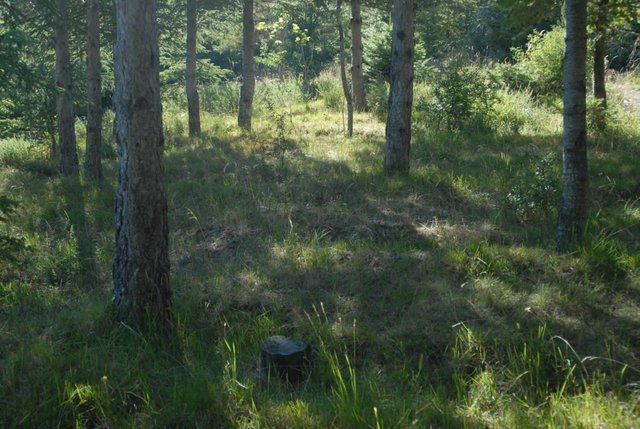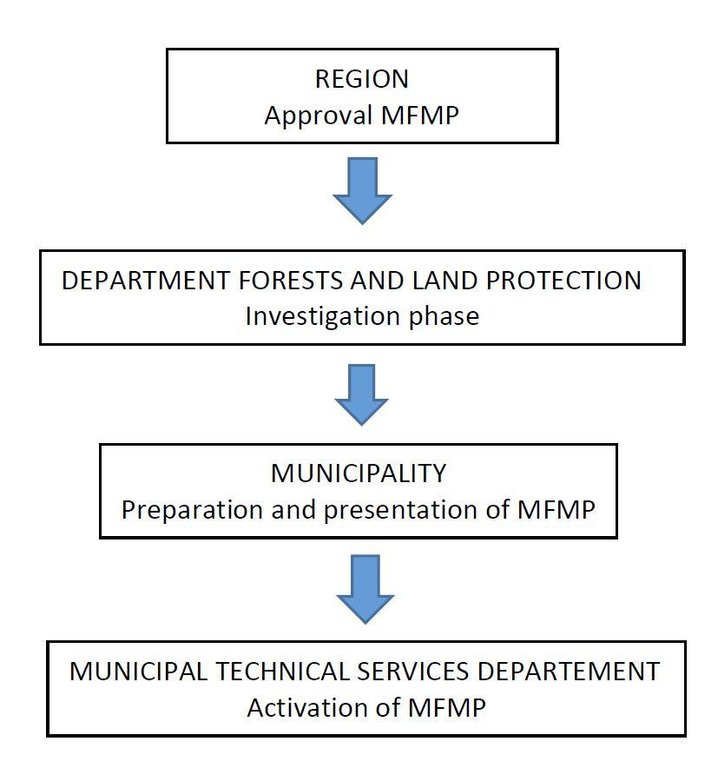Municipal forest management plan -MFMP (decade 2010-2019) [Italy]
- Creation:
- Update:
- Compiler: Velia De Paola
- Editor: –
- Reviewer: Fabian Ottiger
PAF
approaches_2494 - Italy
View sections
Expand all Collapse all1. General information
1.2 Contact details of resource persons and institutions involved in the assessment and documentation of the Approach
SLM specialist:
Quaranta Giovanni
+390971205411
giovanni.quarata@unibas.it
University of Basilicata
Viale dell'Ateneo Lucano 10, 85100 Potenza
Italy
Name of project which facilitated the documentation/ evaluation of the Approach (if relevant)
Catastrophic shifts in drylands (EU-CASCADE)Name of the institution(s) which facilitated the documentation/ evaluation of the Approach (if relevant)
University of Basilicata - Italy1.3 Conditions regarding the use of data documented through WOCAT
When were the data compiled (in the field)?
28/05/2014
The compiler and key resource person(s) accept the conditions regarding the use of data documented through WOCAT:
Yes
1.4 Reference(s) to Questionnaire(s) on SLM Technologies

SELECTIVE CUTTING [Italy]
SELECTIVE CUTTING OF FOREST TREES TO PREVENT FIRES AND AVOID THE RISK OF DAMAGED TREES FALLING DOWN.
- Compiler: Velia De Paola
2. Description of the SLM Approach
2.1 Short description of the Approach
Management plan for silvopastoral areas with a ten year intervention plan
2.2 Detailed description of the Approach
Detailed description of the Approach:
Aims / objectives: The management plan is a legally binding document which outlines an analysis of the current situation of the forest and pastures and gives indications on the best future interventions to ensure their sustainable future management.
The MFMP provides prescription to: cutting periods and tree ages, forest cultivation care, opening of firebreaks and their maintenance, allowance of grazing animals in the forest area, etc.
Methods: This legislative instrument, provides provisions and directions wich have to be followed and wich are legally binding in the local territory the plan covers. Any violations of the plan will result in sanctions.
Stages of implementation: The MFMP is a commitment of the municipality imposed by the Region. The Region provides funds to both to build and implement it when it has been approved. A specific forestry committee is appointed by the Region who provides the technical support to approve the MFMP presented by the municipalities.
Role of stakeholders: Stakeholders participate in drawing up the plan (at a municipal level) which is then approved at a regional level.
2.5 Country/ region/ locations where the Approach has been applied
Country:
Italy
Region/ State/ Province:
Basilicata
Further specification of location:
Castelsaraceno
2.6 Dates of initiation and termination of the Approach
Indicate year of initiation:
2010
2.7 Type of Approach
- recent local initiative/ innovative
2.8 Main aims/ objectives of the Approach
The Approach focused mainly on SLM with other activities
The land-use plan has the general objective of managing public forests and rangelands.
The SLM Approach addressed the following problems: The management plan aims at a correct, rational and sustainable management of woods and silvo-pastoral areas.
2.9 Conditions enabling or hindering implementation of the Technology/ Technologies applied under the Approach
legal framework (land tenure, land and water use rights)
- enabling
land governance (decision-making, implementation and enforcement)
- enabling
The Forest Management Plan applies exclusively to public lands and so does not affect private property in any way.
knowledge about SLM, access to technical support
- hindering
The technologies aim at preventing fires. However, in public woodland, which makes up the majority of the territory, no-one has a “vested interest” in carried out fire prevention actions and, as such, interventions must be made compulsory under law.
Treatment through the SLM Approach: The management plan, being legally binding, forces the implementation of the two technologies associated with this approach.
3. Participation and roles of stakeholders involved
3.1 Stakeholders involved in the Approach and their roles
- local land users/ local communities
There is minimal participation of women because of the nature of the implementation work.
- SLM specialists/ agricultural advisers
- local government
Regional
- national government (planners, decision-makers)
Municipal Technical Services Department
- Municipality
3.2 Involvement of local land users/ local communities in the different phases of the Approach
| Involvement of local land users/ local communities | Specify who was involved and describe activities | |
|---|---|---|
| initiation/ motivation | passive | Municipality, region, relative associations |
| planning | interactive | During the planning phase local land users help the specialists in identifying the problems facing the territory and in the choice of best technologies to improve land mangement |
| implementation | interactive | |
| monitoring/ evaluation | none | State forest service |
| Research | none |
3.3 Flow chart (if available)
3.4 Decision-making on the selection of SLM Technology/ Technologies
Specify who decided on the selection of the Technology/ Technologies to be implemented:
- mainly SLM specialists, following consultation with land users
Explain:
Both during the drafting of the management plan and in the selection of technologies to implement the specialists consulted with land users.
Decisions on the method of implementing the SLM Technology were made by mainly by land users supported by SLM specialists
4. Technical support, capacity building, and knowledge management
4.1 Capacity building/ training
Was training provided to land users/ other stakeholders?
Yes
4.2 Advisory service
Do land users have access to an advisory service?
Yes
Describe/ comments:
Name of method used for advisory service: Publication in the Regional Official Gazette.; Key elements: Local stakeholders presentation, Distribution of MFMP copies to whum is concerned; When approved, the MFMP is published on Regional Official Gazette. Implementation responsible is the Municipal thought its technical department and forestry services who is also responsible for updating and upgrading it periodically.
Advisory service is quite adequate to ensure the continuation of land conservation activities; the forest service constantly monitors the implementation of the management plan and in cases of violations applies sanctions
4.3 Institution strengthening (organizational development)
Have institutions been established or strengthened through the Approach?
- yes, a little
Specify the level(s) at which institutions have been strengthened or established:
- local
- dissemination of paf
4.4 Monitoring and evaluation
Is monitoring and evaluation part of the Approach?
Yes
Comments:
area treated aspects were regular monitored by other through observations; indicators: State forest service
There were no changes in the Approach as a result of monitoring and evaluation
There were no changes in the Technology as a result of monitoring and evaluation
5. Financing and external material support
5.1 Annual budget for the SLM component of the Approach
If precise annual budget is not known, indicate range:
- 2,000-10,000
Comments (e.g. main sources of funding/ major donors):
Approach costs were met by the following donors: local government (district, county, municipality, village etc) (70% region, 30% municipality): 100.0%
5.2 Financial/ material support provided to land users
Did land users receive financial/ material support for implementing the Technology/ Technologies?
Yes
5.3 Subsidies for specific inputs (including labour)
- none
If labour by land users was a substantial input, was it:
- paid in cash
5.4 Credit
Was credit provided under the Approach for SLM activities?
No
6. Impact analysis and concluding statements
6.1 Impacts of the Approach
Did the Approach help land users to implement and maintain SLM Technologies?
- No
- Yes, little
- Yes, moderately
- Yes, greatly
Since the region adopted the Forest Management Plan for each municipality the management of woods and silvo-pastoral areas has been much more sustainable compared to the past.
Did the Approach empower socially and economically disadvantaged groups?
- No
- Yes, little
- Yes, moderately
- Yes, greatly
Did other land users / projects adopt the Approach?
- No
- Yes, little
- Yes, moderately
- Yes, greatly
Larger owners adopted some measures of the path although they were not obliged.
Did the Approach lead to improved livelihoods / human well-being?
- No
- Yes, little
- Yes, moderately
- Yes, greatly
With the Forest Management Plan the income from the sale of woods is much more stable and constant over the years.
Did the Approach help to alleviate poverty?
- No
- Yes, little
- Yes, moderately
- Yes, greatly
6.2 Main motivation of land users to implement SLM
- rules and regulations (fines)/ enforcement
6.3 Sustainability of Approach activities
Can the land users sustain what has been implemented through the Approach (without external support)?
- no
6.4 Strengths/ advantages of the Approach
| Strengths/ advantages/ opportunities in the land user’s view |
|---|
| The Forest Management Plan was first viewed with suspicion as another example of red tape but then during its implementation land users saw the benefits it brought and even private land owners began implementing the same technologies on their own land. (How to sustain/ enhance this strength: They rely on public funding for implementation.) |
| Strengths/ advantages/ opportunities in the compiler’s or other key resource person’s view |
|---|
| The Forest Management Plan plays a vital role in local land management. It is revised and renewed every ten years which allows for a periodic re-assessment of changes to economic and environmental conditions. (How to sustain/ enhance this strength: Public funding must be guaranteed for actions as interventions aim at protecting public resources. ) |
6.5 Weaknesses/ disadvantages of the Approach and ways of overcoming them
| Weaknesses/ disadvantages/ risks in the compiler’s or other key resource person’s view | How can they be overcome? |
|---|---|
|
The only disadvantage is the high initial costs to draft the plan. After the first 10 years the costs for updating the plan are greatly reduced so that costs are ultimately spread out over the long term. |
The only thing which garantees the adoption of the plan is public funding. |
7. References and links
7.1 Methods/ sources of information
- field visits, field surveys
- interviews with land users
Links and modules
Expand all Collapse allLinks

SELECTIVE CUTTING [Italy]
SELECTIVE CUTTING OF FOREST TREES TO PREVENT FIRES AND AVOID THE RISK OF DAMAGED TREES FALLING DOWN.
- Compiler: Velia De Paola
Modules
No modules


